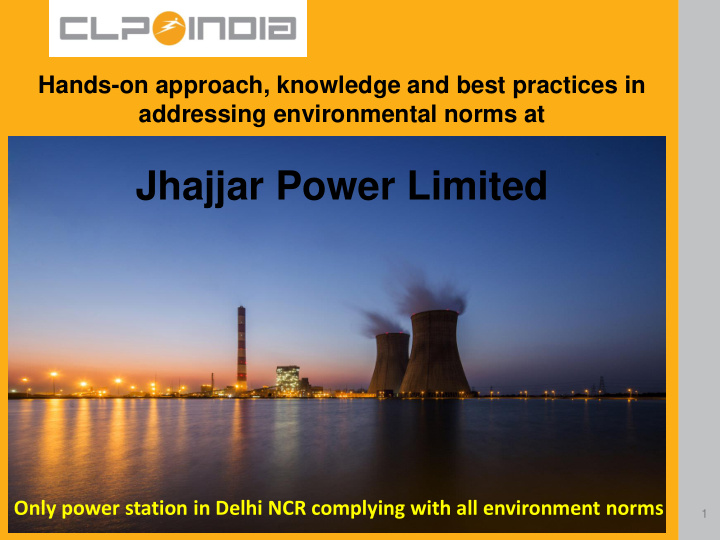



Hands-on approach, knowledge and best practices in addressing environmental norms at Jhajjar Power Limited Only power station in Delhi NCR complying with all environment norms 1
About CLP Group Head-quartered in Hong Kong Total Generation Capacity: 20GW+ China: Mainland – 6,649 MW • One of the largest foreign investors in Chinese power sector. Hong Kong - 6,908 MW • Largest energy supplier of Hong Kong. Thailand/Taiwan - 832 MW India – 3,026 MW • 1320 MW Thermal+655 MW CCPP • 1051 MW Wind + Solar Australia – 3,190 MW • 3rd largest integrated utility 2
Source: The Hindu news paper dated 18-Oct-2019 Jhajjar Power Limited is recognized as the most compliant and clean power plant in Delhi - NCR 3
Managing Environment at JPL Some key achievements: • Certified ISO 14001 power station since 2014. • 36% Green belt coverage area. • Real time emissions data transfer to HSPCB and CPCB. • 100% Ash Utilization. • Winner of Mission Energy Award-2016 for Environment compliance • Winner of TERI Award-2019 for water conservation • Member of CII’s key policy advisory committee.
JPL Introduction: 5
Compliance Summary Emission Statutory JPL Emission Technology Parameters Limits Level PM 50 < 30 Hybrid ESP + Bag filter (mg/Nm 3 ) 300 >95% By combustion tuning, NOx • Low NOx burners (It may be complied at (mg/Nm 3 ) • SOFA damper control revise to 450) full load SO 2 FGD operational from 1st 200 150 to 160 (mg/Nm 3 ) Feb 2019. Mercury 0.03 < 0.0001 NA (mg/Nm 3 ) (BDL) Water Use Zero Liquid Discharge & 3.5 < 2.5 (M 3 /MWh) Dry Ash Handling System 6
Air pollution control devices at JPL • PM Control : Hybrid ESP + Bag Filter. • NOx : Low NOx burners with Secondary Over Fired Air control. • SOx : Wet Flue Gas Desulphurization (FGD) System 7
NOx Control
NOx control • Appointed Finland based consultant - Fortum • Hot flame and oxygen streams were simulated by CFD technique • Implemented new SADC and SOFA dampers curves • Tuning of individual burner and coal auxiliary air damper. Result Achieved: Compliance Before After Part Load Full load Part Load Full Load Unit-1 38% 95% 83% 98% Unit-2 2.5% 34% 81% 93% 9 (corrected in terms of NO 2 @ 6% O 2 )
Plan for Ultra Low NOx Burners • Successfully installed at our Castle Peak Plant, Hong Kong by Doosan Babcock. • NOx < 300 mg/Nm3 (at all loads) Conventional Ultra Low NOx Low NOx Burners Burners Burners 10
SOx Control
Broad Specifications of JPL FGD: Parameters Design Values Sulphur in coal 0.35% 1094 mg/Nm 3 Absorber Inlet SO 2 108 mg/Nm 3 FGD Outlet SO 2 Desulfurization Efficiency 90.1% Flue gas Inlet Temperature 125 deg C. Operating Condition 40% - 100% BMCR 12
Chemical Reaction: 13
Schematic Overview of Wet LS FGD Limestone feeder Wet ball Mill 14
Absorber Tower Details: Agitators 4 agitator (SS make) Spray Bank Three Layer, FRP pipes Shell Carbon steel lined with Spray Made from silicon Material glass flake resin Nozzles carbide
Process Control • SO 2 absorption is controlled by: ✓ Bypass damper opening ✓ pH and density of slurry ✓ No of Recirculation pumps in service • Slurry density : 1100 to 1150 kg/m 3 by gypsum bleeding and water addition through demister spray • pH control: 5.4 ~ 5.8 by adding lime stone • Demister DP control: Maintain DP<200 Pa by washing cycle and adding formic acid
Parameters affecting performance: • Boiler Load • Liquid to Gas Ratio (7.8) - higher is better • Gas and liquid distribution • Gas velocity (3- 4.5 m/s) • Healthiness of mist eliminator • Chloride control (lesser the better) • Limestone fineness • Absorber tank pH and density • Reagent (Ca/S ions) ratio 1.02 to 1.05 17
Limestone handling equipment: Limestone Grizzly Limestone Crusher Limestone Feeder Wet Ball Mill
Oxidation process • Calcium sulfite is oxidized to Calcium Sulphate. Oxidation Blower supplies air for reaction in the absorber. Oxidation Air Fans Oxidation Air Lance tubes
Vacuum belt Feeder: ( Gypsum Dewatering System)
Challenges faced while commissioning FGD plant
Performance Challenges: Low Sox removal efficiency ( 70% as against 90%) • Switch over from blowdown to clarified water • Changing raw limestone quality • Improving wet ball mill fineness • Periodic maintenance of spray nozzles. • Regularized demister washing cycle • Increased L/G ratio by recirculation pump speed increase (Gearbox and Motor upgrade) 22
Performance Challenges: Poor gypsum quality • Improved hydro-cyclone performance • Commissioned waste water system • Increased slurry retention time • Maintaining optimal pH ( 5.4 to 5.8 ) • Improving wet ball mill fineness • Vacuum belt cloth replacement 23
Performance Challenges Poor Mist Eliminator performance • Revised wash cycle sequence • Dosed of formic acid • Proper sequencing done to stop hammer blow effect on washing pipes and valves • Periodic maintenance of wash valves and nozzles Slurry carryover from chimney • Plant stopped • Replaced sticky limestone with non sticky • Demister washed • Attended Booster Fan hydraulic oil leakage 24
Redundancy improvement: • ID fan upgrade project • Emergency tank modification work • Additional Limestone slurry preparation stream • Sump pit interconnection work 25
Mr. Dilip Khatri Vice President – O&M Mobile: 708113218 Know more about us @: Email: dilip.khatri@clpindia.in Website: Mr. Ankit Sapra https://www.clpindia.in Deputy Manager- Production LinkedIn: Mobile: 8198900918 https://www.linkedin.com/company/clp- Email: ankit.sapra@clpindia.in power-india-pvt-ltd/ 26
Recommend
More recommend